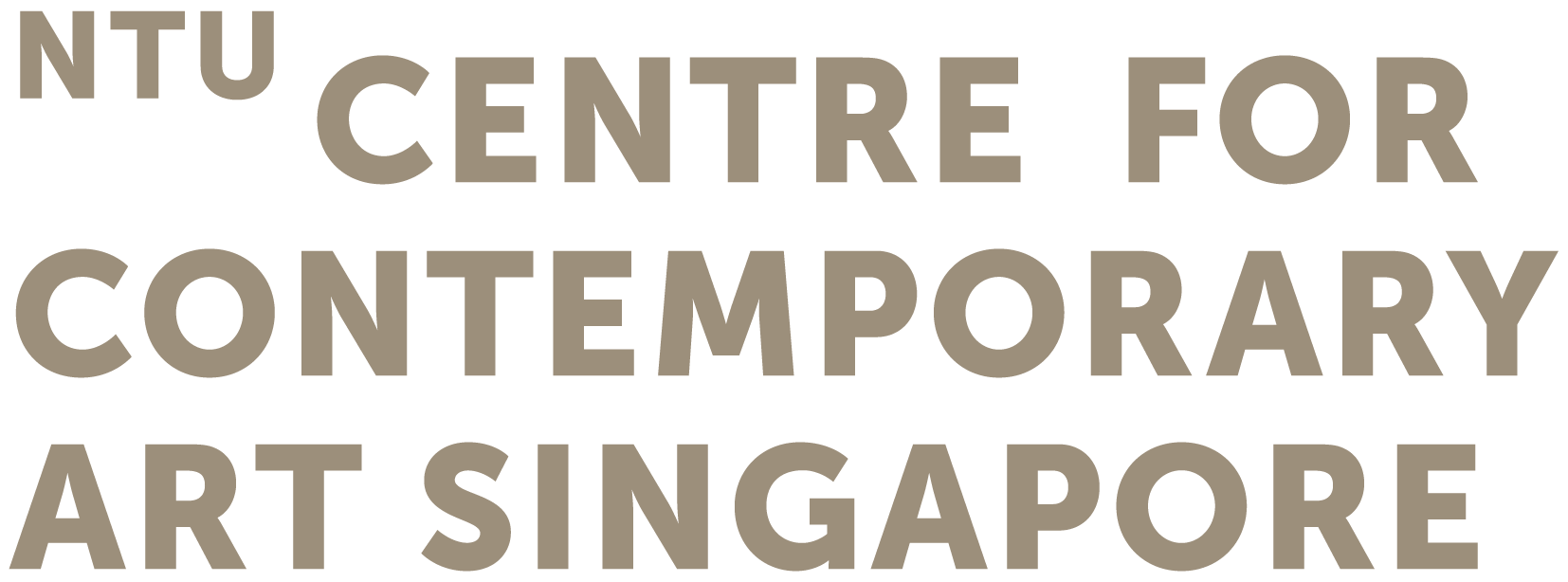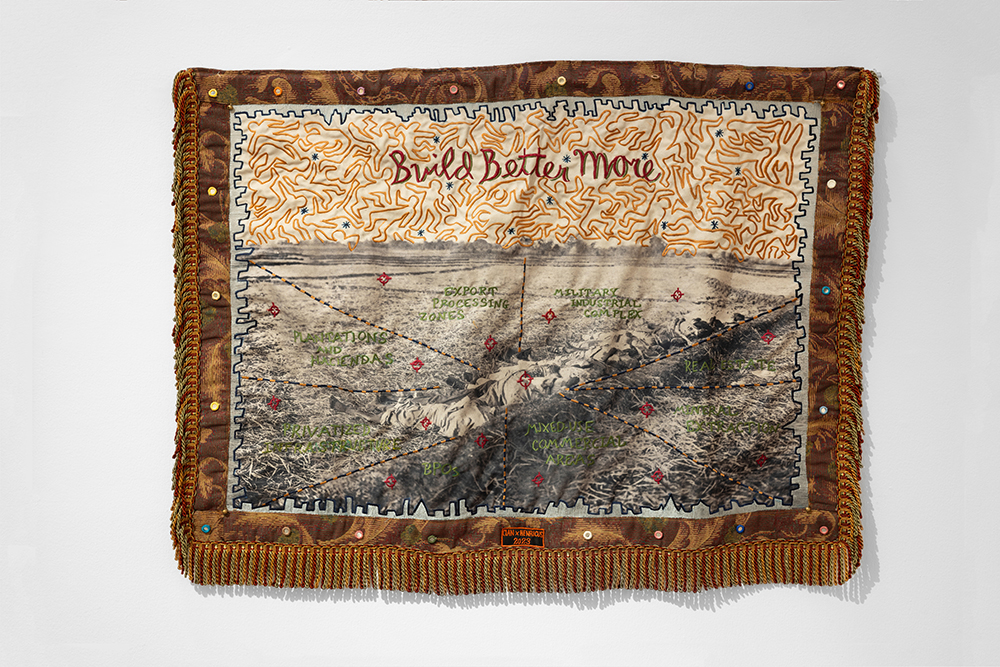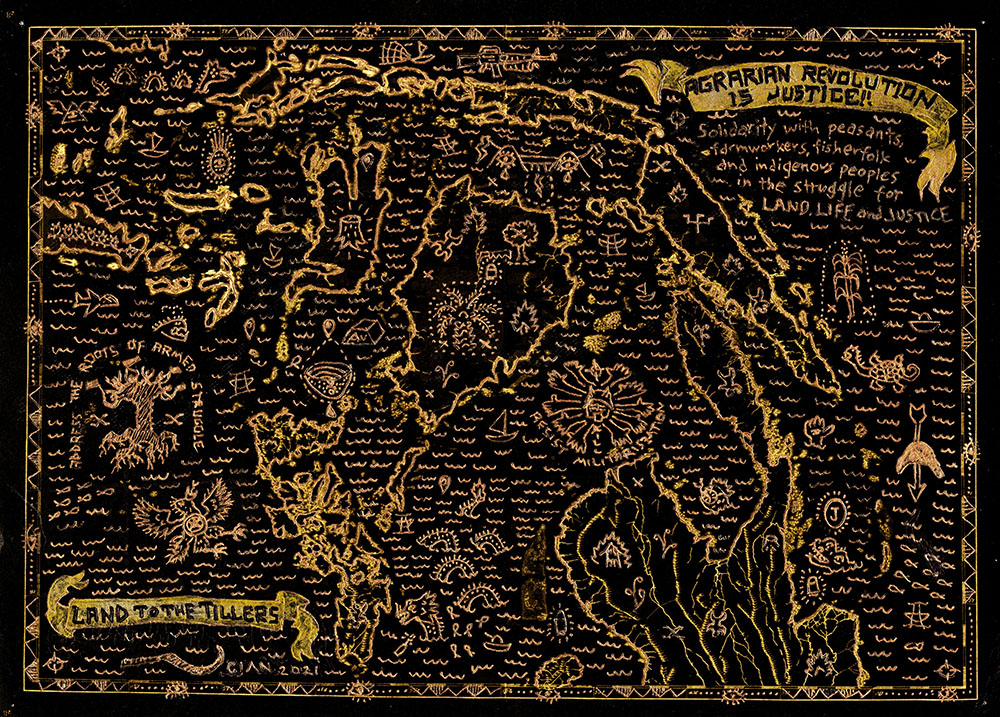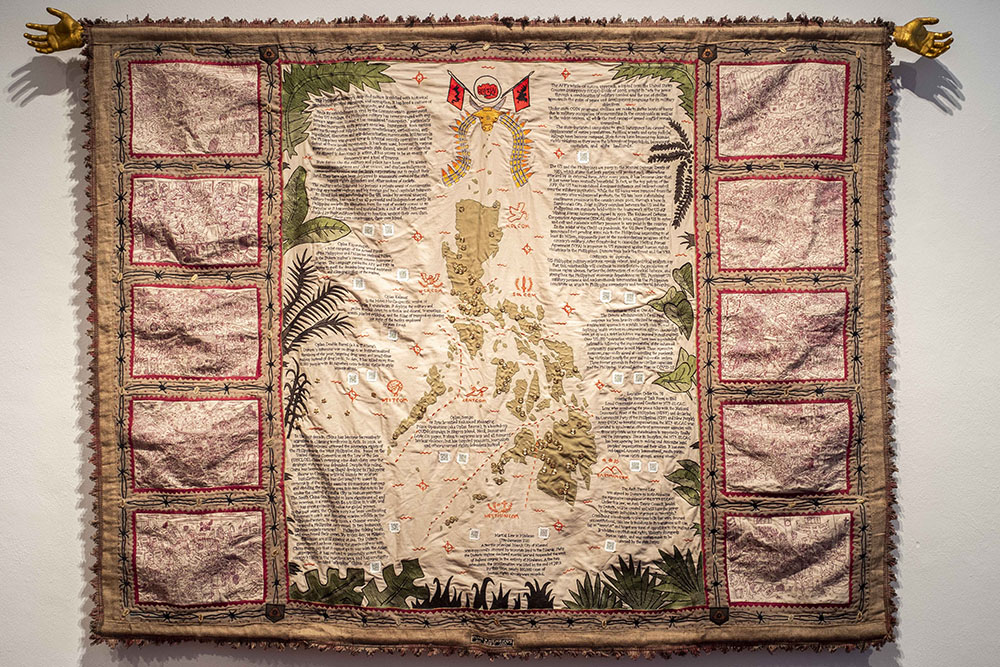
Projects
Fever Dreams of Progress
When The Land Beneath Our Feet Shakes
Blueprint of Dam as Sadistic Monument
Tropical Terror Tapestry
IP Map
Fever Dreams of Progress
Part of a series entitled Fever Dreams of Progress, Cian Dayrit's wall hangings feature archival photographs dating back to the period of the American colonization of the Philippines. These images literally ground the work in history, which Dayrit then annotates with embroidered text and illustrations, drawing attention to the environmental and human costs of capitalist progress. The first, which shows a row of peasant bodies lying in a field, critiques neoliberal developmental policies, which fail to preserve agricultural and forest land instead parceling it out to extractive, destructive, and profit-driven industries, as Dayrit's annotations highlight. The second addresses the harmful legacy of the so-called "Green Revolution," a push to industrialize agriculture across the Global South through the adoption of genetically modified high-yield seeds, chemical fertilizers and pesticides, and intensive irrigation and drainage technologies. In Dayrit's work, peasants tilling the field are shrouded in red barbed wire as green syringes rain down on them like bombs, the chemical plant (cynically labelled "research institute") looming in the background their most likely source [1].
[1] Green Art Gallery, “Hangama Amiri, Cian Dayrit, Melissa Joseph, Lebohang Kganye, Jagdeep Raina, Raed Yassin,” Ocula (Ocula, 2023), https://ocula.com/art-galleries/green-art-gallery/exhibitions/textiles/.
When The Land Beneath Our Feet Shakes
Blueprint of Dam as Sadistic Monument
Cian Dayrit’s work investigates notions of power and identity as they are represented and reproduced in monuments, museums, maps and other institutionalised media. His works often respond to different marginalised communities, encouraging a critical reflection on colonial and privileged perspectives in the Philippines and more broadly. His projects, which combine archival references, protest imagery and grassroots counter-mapping, show how empires scored out the maps of the modern world, how the aftermath perpetuates industrial development, and how alternative territories might be imagined from the ground up.
Blueprint of Dam as Sadistic Monument is a new commission for rivus drawing on Dayrit’s research, activism and community counter-mapping projects around five rivers across the Philippines. All are, or were, threatened by large dams that impede their flow and affect the communities and ecosystems they sustain. They are the Chico river dam/Ampit dam in the Cordillera region; Balog-balog dam in Zambales, Central Luzon region; Kaliwa-Kanan-Laiban dam in Tanay and Quezon provinces; Jalaur dam in Panay island; and Pulangi dam in Mindanao.
Tropical Terror Tapestry
The large piece Tropical Terror Tapestry (2020) consists of a dense infographic quilted map that includes the current regime’s military enclaves and a topological overview of different counterinsurgency programs—technologies of state terrorism presently being waged against the “internal enemy,” the Filipino people. Embroidered side-panels depict diverse methods of militarism being used in these campaigns, as well as military camps, red-tagging of activists, forced displacement, and air raids against peasant and Indigenous communities—operations that have intensified during the Covid-19 crisis. For Dayrit, such topographical threadings are tools in themselves, anting-anting weapons of everyday artistry for self-education and resistance.
Biography
Cian Dayrit (b. 1989, Philippines) is a Manila-based artist who works with paintings, sculptures, and installations. His interdisciplinary practice explores colonialism and ethnography, archaeology, history, and mythology. Dayrit subverts the language and workings of institutions such as the state, museums, and the military to understand and visualize the contradictions these platforms and formats are built upon.
His known series of cartographic artworks often materialise as embroidery, textile, and mixed media collages. They plot the patterns of imperialism and feudalism in the extraction of natural resources and the displacement and exploitation of marginalized populations. At the same time, the works summon new imaginaries that recognize the overlapping socio-political struggles and periods of resistance. His multimedia works examine how the empire scored out current maps of the modern world, how its aftermath perpetuates industrial development at the expense of the common people, and how alternative territories might be imagined from the ground up. Through narratives that expose the inner workings of imperial powers, Dayrit’s work invites us to reconsider how we spatially perceive and interpret the world. While informed by the experience of colonialism from the perspective of the Philippines, Dayrit’s work, nonetheless, defies being tied to a specific position or location. Instead, his work and research cross over geopolitical and supranational bearings.
Dayrit studied at the University of the Philippines. He has been exhibited in international biennials, including the Sidney Biennial, Gwangju Biennale; Berlin Biennale for Contemporary Art; Dhaka Art Summit, Bangladesh; New Museum Triennial “Songs for Sabotage” in New York; and Göteborg Biennal. Dayrit has also participated in exhibitions at ParaSite, Hong Kong, Hammer Museum, L.A., the Metropolitan Museum of Manila, and the Museum of Modern Art, Warsaw. In 2019, he was an artist in residence at Gasworks, London.
Conferences
Speaker | Climate Futures #1 Cultures, Climate Crisis and Disappearing Ecologies, Conference, 1-3 December 2022, Jakarta, Indonesia
Conceived by NTU Centre for Contemporary Arts Singapore, in partnership with KONNECT ASEAN and in-kind support of Goethe-Institut Singapore and Jakarta.
Conference Presentation: Beyond the God's Eye: Militant Approaches to Cognitive Maps
Maps are usually impersonal objects that conceal the experiences of the people inhabiting a represented space, yet beneath the cartographic surface are stories upon stories of struggle and survival. Influenced
by his position as artist, scholar, and activist, Dayrit’s presentation outlines his explorations of cognitive mapping as both a cultural and political tool to challenge the hegemonic grids of maps authored by centralised bodies such as the state or corporations. Working within the context of counter-mapping, Dayrit facilitates cognitive mapping workshops with various subsistence communities, indigenous and labour groups. In these pedagogical interventions, geo-narratives are activated to express precarious conditions and systemic oppression as well as collective resistance, whilst producing material that can be further activated for solidarity campaigns. The maps produced in these workshops are raw and intimate articulations of the everyday lives
of populations historically disenfranchised through the conditions of a neo-colonial society. Informed by approaches from humanistic and radical geography and artistic social practice, the method explores the ways in which the narratives of individuals can reflect the shared conditions of their respective communities. In this light, cognitive mapping becomes a process- based approach to building solidarity and collectively articulating shared aspirations.
Selected Exhibitions
Selected Solo Exhibitions
2020 Studies on Colonial Patterns, nome Gmbh/ARCO Madrid, Madrid, Spain
2019 Inclemencies of the Tropical Sun, 1335 Mabini/Frieze London, London
2019 Beyond the God's Eye, Nombe Gmbh, Berlin, Germany
2018 Allegories of Nation-Building, Kaida Gallery, Quezon City, Philippines
2016 Atlas of the Global South, Kaida Gallery, Quezon City
Selected Group Exhibitions
2022 RIVUS, 23rd Biennale of Sydney, Sydney, Australia
2021 Thread and Tensions, Yeo Workshop, Singapore
2020 Starting at the Finish Line, Blanc Gallery, Quezon City, Philippines
2020 We Move Amongst Ghosts, Museum of Fine Arts and Ceramics, Jakarta, Indonesia
2019 Souls, Soil and Sea, Art Informal, Mandaluyong, Philippines
2018 Thirteen Artists Awards Exhibition, Cultural Center of the Philippines, Manila, Philippines
Selected Residencies
2019 Artist-in-residence, Gasworks, London, United Kingdom
2019 Artist-in-residence, Aurora Artist Residency Program and Space (AARPS), Aurora, Philippines
2018 Artist-in-residence, La Trobe Art Institute, Bendigo, Australia
2017 Artist-in-residence, Bellas Artes Projects, Bataan, Philippines
Selected Awards
2018 Thirteen Artists Award, Cultural Center of the Philippines, Philippines
2017 Ateneo Art Award, Philippines







